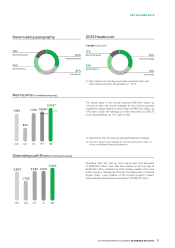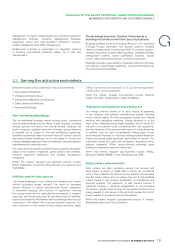APC 2012 Annual Report Download - page 21
Download and view the complete annual report
Please find page 21 of the 2012 APC annual report below. You can navigate through the pages in the report by either clicking on the pages listed below, or by using the keyword search tool below to find specific information within the annual report.
2012 REGISTRATION DOCUMENT SCHNEIDER ELECTRIC 19
OVERVIEW OF THEGROUP’S STRATEGY, MARKETS AND BUSINESSES
1
BUSINESSES, END-MARKETS ANDCUSTOMER CHANNELS
management of mission critical infrastructure (primarily Distribution
Management Software, Operation Management Software,
supervision control and data acquisition (“SCADA”) software,
pipeline management and traffi c management).
Infrastructure business is responsible for integrated solutions
in following end-markets: Electrical utilities, Oil & Gas and
Transportation.
The Buildings business: Number4 Worldwide in
Building Automation and Video Security Systems
Buildings facilitates comfort and energy effi ciency in non-residential
buildings through automation and security systems, including
Heating, Ventilation&Air-Conditioning (“HVAC”) controllers, sensors,
valves and actuators, programmable regulators, centralized building
management systems, space optimization solutions, access
control, video cameras and security monitoring equipment.
Buildings business is responsible for integrated solutions in following
end-markets: Hotels/Retail, Healthcare, Government/Educational,
Life Sciences and Real Estate.
2.2 Serving five attractive end markets
Schneider Electric serves customers in fi ve principal markets:
•Non-residential Buildings;
•Utilities and Infrastructures;
•Industries and Machine manufacturers;
•Data Centres and Networks;
•Residential Buildings.
Non-residential buildings
The non-residential buildings market includes public, commercial
and industrial buildings such as offi ces, hotels, hospitals, shopping
centers, schools and sports and cultural centers. Because this
sector consumes signifi cant amounts of energy, energy effi ciency
is essential and is subject to new and demanding regulations.
Specifi ed requirements have to be met in terms of comfort, security
and environmental friendliness, as do the needs of owners and
building managers seeking to reduce investment costs and optimize
maintenance and operating costs.
Our customers in this sector include end-users, property developers,
design fi rms, systems integrators, panel builders and installers,
electrical equipment distributors and building management
companies.
Within this market, targeted sub-segments include: Hotels/
Retail, Healthcare, Government/Educational, Life Sciences and
Real Estate.
Utilities and infrastructures
The global challenges in the utilities and infrastructure market
include increasing energy demand, the need for increased
energy effi ciency to reduce environmental impact, expansion
of renewable energies, the evolution of regulations covering
the energy market and in particular the emergence of demand
response, and the growing need for real-time control of facilities,
security and reliability. We believe that the challenges faced by our
customers in this market offer long-term growth prospects. Our
main customers in this market include energy operators, water
utilities, the owners and operators of oil, gas and transportation
infrastructure, and municipalities.
Within this market, targeted sub-segments include: Electrical
utilities, Oil&Gas, Transportation, Water and Marine.
Industries and machine manufacturers
Our energy solutions enable us to serve almost all segments
of the industries and machine manufacturers market, including
mines, cement plants, the food-processing industry and material
handling and packaging machines. Energy effi ciency is at the
heart of the challenges facing these industries, which include the
reduction of production costs, compliance with new regulations,
and the reduction of the environmental impact of industrial activity.
In addition, both the rapid industrialization taking place in new
economies and the need to modernize existing industrial facilities in
mature economies create signifi cant opportunities for growth. Our
customers include end users and companies, engineering fi rms,
systems integrators, OEMs, electro-intensive industries, panel
builders and electrical equipment distributors.
Within this market, targeted sub-segments include: Mining,
Minerals&Metals (“MMM”), Food&Beverage and OEM.
Data centers and networks
Data centers are sites containing servers that process and
store billions of pieces of digital data in secure, air conditioned
room s .They constitute the central nervous systems of businesses
and the public sector, and we believe they are a high-potential
market thanks to the growing digitalization of professional and
personal activities. The expansion of data centers involves a
signifi cant increase in electricity requirements to accommodate
the servers’ operation and cooling, and we expect that the cost of
energy needed to cool server rooms will shortly exceed the cost of
energy needed to operate the servers themselves.
Within this market, targeted sub-segments include: IT industry,
Banking/Insurance and Cloud&Telecom.
























